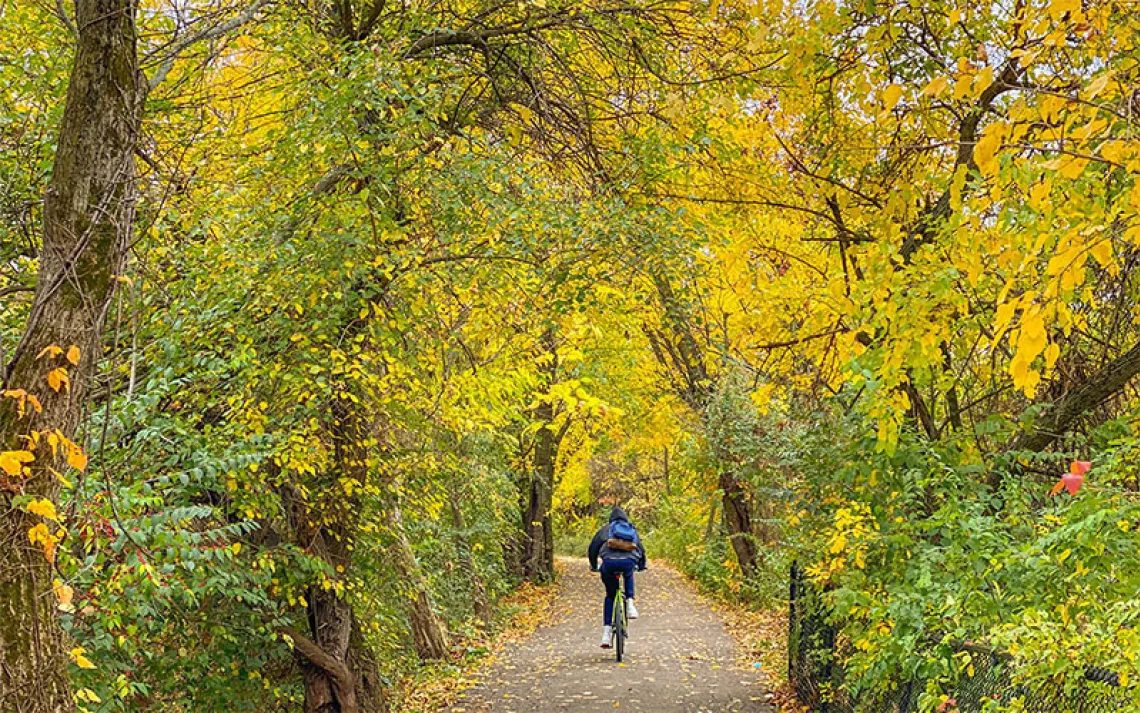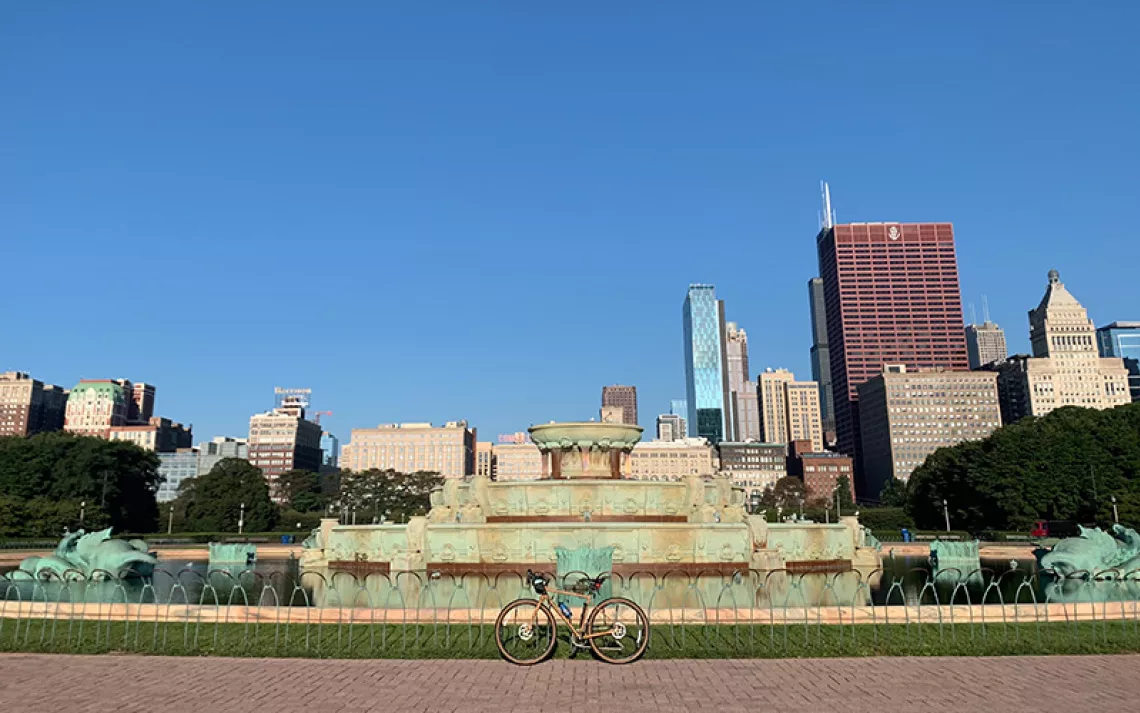Meet the Cyclist-Farmers Working to Solve World Hunger
What you need to know about fleet farming—a.k.a. the front-yard “farmlettes” that are inspiring UN ambassadors

Photos courtesty of Fleet Farming
Many folks nationwide have let their lawns “go brown” to help conserve water. A valiant effort. But a group out of Orlando, Florida, may have come up with a better solution for the 40 million acres of lawn in this country: Convert them into farms.
“That’s essentially wasted, under-utilized space,” says Chris Castro, the cofounder and adviser of an operation called Fleet Farming. “Farms are beautiful but also productive.”
 Castro’s Fleet Farming project, which he founded with Heather Grove and Justin Vandenbroeck, has transformed many private yards into micro-farms (or to use their preferred term, “farmlettes”). The intent is to create a means of hyper-localized urban food production with a near-zero carbon footprint. Fleet farming currently operates in three neighborhoods (Orlando, Oakland, and Jacksonville), with three more in the pipeline (West Orlando, Austin, and Dallas).
Castro’s Fleet Farming project, which he founded with Heather Grove and Justin Vandenbroeck, has transformed many private yards into micro-farms (or to use their preferred term, “farmlettes”). The intent is to create a means of hyper-localized urban food production with a near-zero carbon footprint. Fleet farming currently operates in three neighborhoods (Orlando, Oakland, and Jacksonville), with three more in the pipeline (West Orlando, Austin, and Dallas).
The idea is that homeowners operate as sharecroppers (to use the word in only its most technical sense). The Fleet Farming staff build the farms, transforming water-guzzling lawns into edible gardens, and maintain them for participating homeowners, who get to keep roughly 10 percent of their farmlette’s produce. The homes in a single Fleet Farming branch are all located within a one-mile radius. This is because every two weeks, the Fleet Farming team, along with neighborhood volunteers , ride their bikes through the community in a “swarm,” harvesting the remaining 90 percent of produce and transferring it to farmers' markets and restaurants within a three-mile radius. Then, they sell the fresh, local bounty. Volunteers get a discount on the produce and a free education in urban farming.
“We’re taking the community members on an adventurous urban garden community bike ride every other Sunday,” explains Vandenbroeck, who also functions as an adviser to Fleet Farming. “It’s the heart and the soul of Fleet Farming.”
 The whole thing started in the Audubon Park neighborhood of Orlando in December 2013. Fleet Farming is actually one project among many from IDEAS For Us, a 501(c)(3) nonprofit that Castro cofounded in 2008 to provide funding for community-oriented environmental solutions. During a brainstorming “think tank” session with his local Audubon Park community, which Castro refers to as “the Hive,” local urban farmer John Rife proposed an idea for a bicycle-powered urban farming program. They fleshed out the idea for several months, eventually launching the first Fleet Farm swarm in February 2014, with just five homes participating. Today 20 Audubon Park households are on board, with many more folks, Castro says, wanting to participate.
The whole thing started in the Audubon Park neighborhood of Orlando in December 2013. Fleet Farming is actually one project among many from IDEAS For Us, a 501(c)(3) nonprofit that Castro cofounded in 2008 to provide funding for community-oriented environmental solutions. During a brainstorming “think tank” session with his local Audubon Park community, which Castro refers to as “the Hive,” local urban farmer John Rife proposed an idea for a bicycle-powered urban farming program. They fleshed out the idea for several months, eventually launching the first Fleet Farm swarm in February 2014, with just five homes participating. Today 20 Audubon Park households are on board, with many more folks, Castro says, wanting to participate.
As the project took shape, the team behind Fleet Farming began to see its mission statement as multifaceted. They wanted to help reduce the carbon footprint of food production while also addressing food insecurity in poor, urban food deserts. Lastly, they wanted to address the problem at the root of farming itself—more people live in urban areas now than ever before, so fewer folks know the faintest thing about farming or, if they were interested, where to even start. It’s why the Fleet Farming team members like to say they are “farming farmers.”
“I really feel like we’ve become too disconnected from what goes on behind the scenes in our food,” says Fleet Farming director Lee Perry. “Convenience is nice, but it’s hurting the planet.”
By the fall of 2015, the operation had proved so successful in Audubon Park that IDEAS For Us began work on a branch in West Oakland, with Vandenbroeck taking the leadership role. It was up and running by January 2016.
This second branch gave the Fleet Farming team an opportunity to see whether its pilot project could translate to a different neighborhood. West Oakland, unlike Audubon Park, is a food desert. Vandenbroeck studied the neighborhood and adjusted accordingly. For instance, they had to sell exclusively to restaurants, as no farmers' markets existed within the desired three-mile radius. They were able to team up with WOW (West Oakland Woods) Farm, a youth development farming program for high school students, to secure help with garden maintenance. When Vandenbroeck moved back to Orlando after launching Oakland Fleet Farming, IDEAS For Us successfully looked to WOW Farm for a new Oakland branch manager.
 “The Fleet Farming benefits are going to be realized [through] different methods, depending on the characteristics of that neighborhood,” Vandenbroeck says.
“The Fleet Farming benefits are going to be realized [through] different methods, depending on the characteristics of that neighborhood,” Vandenbroeck says.
Recently, the United Nations has taken an interest in Fleet Farming. Castro, who already had a relationship with the UN thanks to his work with IDEAS For Us, has twice presented on Fleet Farming at UN headquarters in New York City.
“It was surreal to showcase it at that level,” Castro says. “Fleet Farming in the eyes of the United Nations is becoming a tangible solution that could be scaled to other countries, to address ending world hunger.”
Fleet Farming might indeed soon find itself in a whole lot more neighborhoods globally. This past year, IDEAS For Us has been reconsidering how it should expand. Rather than operating branches in new neighborhoods themselves, they intend to sell licenses of Fleet Farming to other trusted nonprofits—much like how a franchise would operate. The first Fleet Farming “franchise” was licensed to Public Trust Environmental Legal Institute of Florida and launched in the Riverside neighborhood of Jacksonville, Florida, in January 2017.
Three other Fleet Farming branches will soon be licensed and operated in the same way. Currently, the team is reviewing 750 requests to open Fleet Farming in other neighborhoods—located all across the United States and in 20 countries.
However, IDEAS For Us is wary of expanding Fleet Farming too quickly—they are most concerned with making the program sustainable. To this end, they’re creating additional streams of revenue outside of the branches’ primary intention—selling local produce to farmers' markets and restaurants. These include starting farm educational programs, offering farming employee engagement services, and offering to help build farms in yards outside of a Fleet’s designated “swarm.”
 One evident benefit that aligns with each operation’s mission statement? Across the board, Fleet Farming is getting members of the community involved in their neighborhoods, and getting people to learn how to better work together, toward a common good.
One evident benefit that aligns with each operation’s mission statement? Across the board, Fleet Farming is getting members of the community involved in their neighborhoods, and getting people to learn how to better work together, toward a common good.
“It’s not just growing food on lawns,” Perry says. “It’s building a sense of community [in places] where otherwise we are just isolated from one another.”
 The Magazine of The Sierra Club
The Magazine of The Sierra Club



